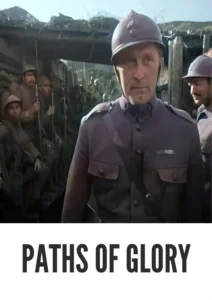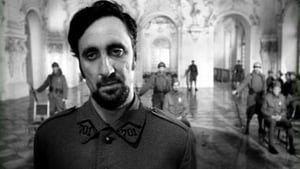Contact: [email protected]
Video Sources 0 Views

Synopsis
Unraveling the Depths of “Paths of Glory” 1957: A Cinematic Masterpiece Review

“Paths of Glory” 1957, a cinematic tour de force directed by Stanley Kubrick, transcends its time and space, leaving an indelible mark on the annals of filmmaking. In this comprehensive review, we delve into the multifaceted layers of this gripping war drama, exploring its themes, performances, and enduring legacy. From its early colored version to its impact on cinema, “Paths of Glory” continues to captivate audiences worldwide.
Check The Full Colorized Movies List
Check Our Colorized Movies Trailer Channel
Introduction: Navigating the Trenches of War Cinema
“Paths of Glory” 1957, a film ahead of its time, deftly navigates the treacherous terrain of war cinema. As we embark on this cinematic journey, we’ll unravel the significance of its early colored version and its lasting impact on the cinematic landscape.
Understanding “Paths of Glory” 1957: Director, Cast, and Genre
At the helm of “Paths of Glory” 1957 is the visionary director Stanley Kubrick, whose meticulous attention to detail and artistic vision infuse every frame of the film. The stellar cast, led by Kirk Douglas, Ralph Meeker, and Adolphe Menjou, delivers powerhouse performances that elevate the narrative to unparalleled heights. Blending elements of war drama and psychological thriller, “Paths of Glory” transcends genre boundaries, cementing its status as a timeless classic.
Exploring the World of “Paths of Glory” 1957: Plot and Characters
Set against the backdrop of World War I, “Paths of Glory” 1957 follows Colonel Dax, portrayed by Kirk Douglas, as he grapples with the moral complexities of military leadership. When three soldiers under his command are unjustly accused of cowardice, Dax embarks on a harrowing journey to challenge the corrupt military hierarchy and seek justice for his men. Along the way, he confronts the brutal realities of war and the inherent injustice of the human condition.
The Art of Film Colorization: Breathing New Life into Classic Cinema
Film colorization has long been a contentious issue in the realm of cinema, with purists arguing for the preservation of original black and white films. However, the early colored version of “Paths of Glory” 1957 offers a fresh perspective on Kubrick’s masterwork, breathing new life into the film and inviting audiences to experience its visceral intensity in vivid detail. While some may view colorization as sacrilege, others see it as a gateway to introducing classic cinema to new generations of viewers.
Early Colored Films: A Brief History
The emergence of early colored techniques in cinema marked a pivotal moment in the history of filmmaking. From hand-tinted frames to early experiments with colorization technology, filmmakers have long sought to enhance the visual impact of their works. “Paths of Glory” 1957, with its early colored version, represents a milestone in this ongoing evolution, showcasing the potential of colorization to enrich the viewing experience without compromising the integrity of the original film.
“Paths of Glory” 1957 and Its Early Colored Version: A Visual Spectacle
The decision to release “Paths of Glory” 1957 in a colorized format was met with both anticipation and apprehension. However, the early colored version of the film succeeds in capturing the essence of Kubrick’s vision while adding a new layer of visual richness to the narrative. From the lush green landscapes of the French countryside to the stark contrast of the battlefield, colorization enhances the film’s immersive quality, drawing viewers deeper into its world of conflict and intrigue.
The Debate Over Film Colorization: A Controversial Legacy
The controversy surrounding the colorization of black and white films continues to simmer within the film community. While proponents argue that colorization breathes new life into classic cinema, purists maintain that it detracts from the artistic integrity of the original work. “Paths of Glory” 1957, with its early colored version, finds itself at the center of this debate, sparking discussions about the ethical and aesthetic implications of altering cinematic classics.
Examining “Paths of Glory” 1957 as an Early Colored Film: A Critical Analysis
As we analyze “Paths of Glory” 1957 in its early colored format, we must consider how colorization impacts the overall viewing experience. While some may argue that colorization detracts from the film’s gritty realism, others contend that it offers a fresh perspective on Kubrick’s masterpiece, highlighting nuances and details that may have gone unnoticed in black and white. Ultimately, the decision to watch “Paths of Glory” 1957 in its original or colorized format is a matter of personal preference, with each version offering its own unique merits.
Influence and Legacy: “Paths of Glory” 1957’s Impact on Cinema
“Paths of Glory” 1957 has left an indelible mark on the cinematic landscape, inspiring generations of filmmakers and shaping the trajectory of war cinema. Its influence can be seen in subsequent works, from anti-war films to psychological dramas, as directors draw inspiration from Kubrick’s bold storytelling and uncompromising vision. The Western remake trend sparked by “Paths of Glory” 1957 serves as a testament to the film’s enduring legacy, with directors like Sergio Leone paying homage to Kubrick’s groundbreaking work.
Director’s Cinematic Legacy: Kubrick’s Enduring Influence
Stanley Kubrick’s legacy extends far beyond “Paths of Glory” 1957, encompassing a diverse body of work that has left an indelible mark on the world of cinema. From “2001: A Space Odyssey” to “A Clockwork Orange,” Kubrick’s films continue to captivate audiences with their unparalleled craftsmanship and provocative storytelling. His influence on local and international filmmaking is immeasurable, with directors and cinephiles alike drawing inspiration from his bold vision and uncompromising commitment to excellence.
Themes Explored in “Paths of Glory” 1957: Darkness, Morality, and Human Nature
“Paths of Glory” 1957 delves into the darkest recesses of the human psyche, exploring themes of morality, honor, and the futility of war. Kubrick’s unflinching portrayal of the human condition resonates with audiences, challenging them to confront uncomfortable truths about the nature of power and corruption. From the callous indifference of military leaders to the courage and resilience of the soldiers on the front lines, “Paths of Glory” 1957 offers a searing indictment of the human capacity for cruelty and compassion.
Reception and Controversy Surrounding “Paths of Glory” 1957
Upon its release, “Paths of Glory” 1957 garnered widespread critical acclaim for its bold storytelling and uncompromising vision. Critics praised Kubrick’s direction and the performances of the cast, hailing the film as a masterpiece of war cinema. However, the film’s stark portrayal of the brutality of war and its indictment of military authority sparked controversy, with some audiences and critics decrying its anti-establishment stance. Nevertheless, “Paths of Glory” 1957 has stood the test of time, earning its rightful place among the pantheon of cinematic classics.
Where to Watch “Paths of Glory” 1957 Online: A Streaming Guide
For cinephiles eager to experience “Paths of Glory” 1957 in all its glory, there are several options available for streaming the film online. Platforms like Amazon Prime Video, iTunes, and Google Play offer digital rentals and purchases of the film, allowing viewers to enjoy Kubrick’s masterpiece from the comfort of their own homes. Additionally, classic film streaming services like Criterion Channel and FilmStruck may feature “Paths of Glory” 1957 as part of their curated collections, providing access to a treasure trove of cinematic gems.
FAQs About “Paths of Glory” 1957: Answering Common Queries
For those seeking more information about “Paths of Glory” 1957, here are answers to some frequently asked questions:
- Is “Paths of Glory” 1957 based on a true story? Yes, the film is loosely based on the novel of the same name by Humphrey Cobb, which was inspired by real events during World War I.
- Did “Paths of Glory” 1957 win any awards? While the film did not receive any Academy Award nominations, it has since been recognized as one of the greatest films ever made by critics and audiences alike.
- What is the significance of the title “Paths of Glory”? The title is derived from a line in Thomas Gray’s poem “Elegy Written in a Country Churchyard,” which reflects on the transient nature of human achievement and the inevitability of death.
Conclusion: Honoring Kubrick’s Artistic Vision
“In Paths of Glory” 1957, Stanley Kubrick crafted a cinematic masterpiece that continues to resonate with audiences decades after its release. Whether viewed in its original black and white format or in its early colored version, the film offers a poignant and thought-provoking exploration of the human condition in times of conflict. As we reflect on Kubrick’s enduring legacy and the ongoing debate surrounding film colorization, let us honor the artistic vision and uncompromising commitment to excellence that define “Paths of Glory” 1957.




















